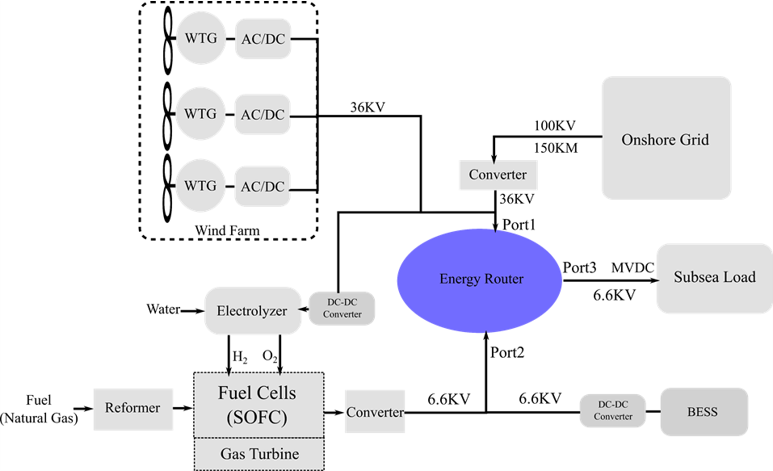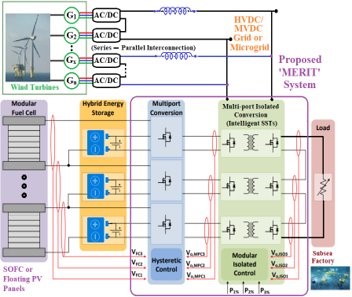Multi-Port Energy Router Using Intelligent Transformers (MERIT) to Interconnect Renewable Resources and Subsea Oil & Gas Factories via HVDC Link
Status: AWARD END DATE: 03/31/2022
Background:
Nearly 1,500 oil and gas (O&G) rigs are located offshore across the globe, the largest share of which are in the North Sea and Gulf of Mexico. The recent trend in O&G industry is to install the subsea processing loads on the seabed for reducing the required space on the platform or even removing the platform altogether. The subsea processes (or subsea factory) include gas compression, boosting, water injection, and separation. Typical power consumption of the Subsea loads is in the range of 5-300 MW, traditionally supplied by local gas turbines or diesel generators. Such power generation strategies have led to significant increase in greenhouse gas emissions. Also, the electric distribution system of O&G platforms is characterized as a weak electric grid, resulting in poor power quality, lower power factor, voltage and current harmonics, voltage notches, and common mode voltages. All these result in increased losses and also affect the long-term reliability.

This project proposes a system of Multi-port Energy Routers using Intelligent Transformers (MERIT) to interface renewable resources and subsea O&G factories with the HVDC (or MVDC) Grid. In this project, we will investigate combining the energy from wind, wave, floating PV panels and fuel cell - based generators, all located near the subsea factories, to power the loads. Intelligent power converters, including solid state transformers (SSTs), are critical to enhance the power density, reliability and efficiency of the proposed MERIT system. SSTs enable seamless interconnectivity and interoperability between the various energy sources. SSTs support features such as instantaneous voltage compensation, power outage compensation, fault isolation, bi-directional power flow, etc. This research will also investigate how to optimally design and integrate SSTs into the MERIT system to have the best performance both during transient and steady state conditions. It is expected that widespread implementation of the proposed synergies can lead to over 50 % reduction in emissions.
As one of the foremost requirements of a subsea power delivery system is reliability, HVDC protection units must conform to extremely stringent specifications in terms of fault interruption time and fault level. However, a major challenge in the growth of DC power market is the lack of reliable protection against short-circuit faults. A fault in a DC system results in fast ramp up of the fault current. Moreover, DC fault current does not experience any natural zero-crossing. Therefore, DC circuit breakers (DCCBs) should be capable of fast fault quenching in order to prevent damage to the DC system and maintain grid resiliency. Additionally, a DCCB should operate with minimal power loss as a closed switch. Fault interruption using a DCCB causes enormous energy dissipation and voltage stress. If a DC fault current is 4-5 times higher than the rated DCCB, then it cannot work efficiently without expanding its components. Therefore, the use of a fault current limiter is essential, and the superconducting fault current limiter (SFCL) is the most promising choice together with a fast-switching DCCB in series. Resistive type superconducting fault current limiter (R-SFCL) is one of the most ideal, compact, small size current limiting devices to protect the power system and electrical equipment. It can limit the fault current effectively in power systems where CBs can work safely and prevent damage to the circuit components within several milliseconds.
Additional Media Assets:

Overarching Goal:
To design and develop a MERIT system for integrating renewable energy sources, energy storage and the Medium-Voltage Direct Current (MVDC) grid with the subsea loads. The project also explores the control strategy of the MERIT system to reduce the intermittency of the renewable energy sources, in order to ensure the safety and stability of the grid interconnection. Another goal is to assess the performance of Coupled Inductor Hybrid Circuit Breaker (CIHCB) Topology with integration of Resistive-Superconducting Fault Current Limiter (R-SFCL)
Industry Impact:
The estimated financial loss for incidents due to poor power quality in the O&G sector is $300,000-800,000 a day. To increase the energy efficiency and reduce the CO2 and NOx emissions, several solutions have been proposed in the literature. Among these solutions, the supply of electric power to the subsea loads from the shore as HVAC (50 Hz/60 Hz) or HVDC power transmission has been increasingly examined. In addition, other techniques such as low frequency AC transmission from the shore have also been considered. In order to supply reliable power to the subsea loads at high system efficiency and low emissions, there is a growing interest in employing offshore renewable resources close to the point of use. However, such a system has predominantly stayed in the conceptual stage so far. Hence, there is a compelling need to develop technical methodologies for interconnecting multiple megawatt-scale systems offshore. The MERIT system incorporates features like instantaneous voltage compensation, power outage compensation, fault isolation, and bi-directional power flow capability. Widespread implementation of the developed synergies will improve the economics of both renewables and oil and gas projects and can lead to over 50% reduction in the emissions caused by the activities in oil and gas production.
Project Goals:
The overarching aim of the proposed project is to explore and develop a system of Multi-port Energy Routers using Intelligent Transformers (MERIT) to interface renewable resources and subsea oil and gas (O&G) factories with the High Voltage DC, ‘HVDC’ (or Medium Voltage DC, ‘MVDC’) Grid. This research intends to advance the state-of-the-art power converter hardware and control technologies to enable seamless energy transfer between offshore renewable energy sources, subsea loads (such as in O&G factories) and the DC grid to improve the system efficiency, reliability and availability. The project will also evaluate the integration of fault current limiters including the possibility of adding resistive superconducting fault current limiter (R-SFCL) in series with hybrid DC circuit breakers (HCBs) to lower the high fault current to such a level where circuit breakers can operate safely.
Tasks:
- Study the different types of loads in an offshore oil & gas (O&G) production system, focusing on the subsea factories and design the electrical architecture of an offshore wind energy farm to interface with the DC grid (Type of Tasks: software and real-time simulation)
- Design a MERIT system to interconnect hybrid renewable energy sources (including wind and fuel cells) with subsea loads (Type of Tasks: software and real-time simulation)
- Explore the integration of additional renewable energy sources – such as floating solar photovoltaic (PV) panels, battery energy storage (BES) and wave energy – with the MERIT system in order to supply 100 % of the demand of the subsea factory using renewable energy resources via HVDC or MVDC link (Type of Tasks: software and real-time simulation)
- Design, build, control and evaluate a lab-scale three-terminal MERIT system using solid state transformer (SSTs) as a proof of concept (Type of Tasks: hardware experiments)
- Investigate the fault limiting performance of a coupled-inductor based fast switching DCCBs (Type of Tasks: software simulations)
- Evaluate fault interruption capability under various network conditions to obtain the optimum configuration with R-SFCL integrated in series with DCCB (Type of Tasks: software simulations)
Gantt Chart:

Highlights:
- Completed study of electrical loads in offshore O&G production system
- Simulated system level architecture to interconnect offshore wind farm via DC collection grid
- Task I completed
- Discussion with industry partners on the voltage/power levels, made design updates
- Design and development of the proposed MERIT system to interconnect multiple renewable energy sources with subsea loads
- Simulation of fault interruption of CIHCB and the modular DCCB
Key Findings:
- Obtained the load profile of a typical subsea field. To supply the power to the subsea field, the required number of wind turbines and backup energy sources were determined
- Developed electrical architecture of a subsea field with an energy router to interface wind power and backup energy sources
- Multiport Energy Router (MER) was realized by using series-parallel combination of medium frequency based Triple Active Bridge Converters to achieve considerable reduction in footprint in the offshore platform
- Developed energy management scheme for the MERIT system facilitates. The intermittency of the wind power can be mitigated
- Optimized number of the wind turbine, solar panels, wave energy converter and battery storage capacity to operate the MERIT system autonomously. Cost of the generated renewable energy will be minimum due to the adopted optimization technique
- Proposed a control scheme for the MER for controlling the power flow among the ports
- Verified the performance of R-SFCL integrated coupled inductor hybrid circuit breaker (CIHCB) topology
- Considering the fast response times and reduction in ratings of main breaker, integration of R-SFCL with proposed DC circuit breakers is an optimal solution for protection of subsea HVDC systems